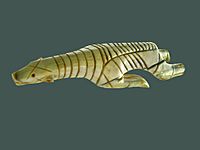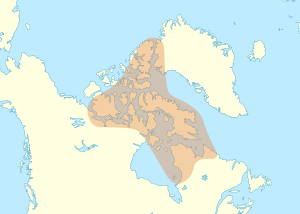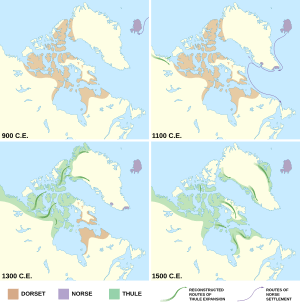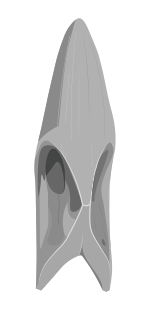Dorset culture facts for kids
The Dorset was an ancient culture of people who lived in the North American Arctic. They were part of the Paleo-Eskimo group. The Dorset culture existed from about 500 BC to between 1000 AD and 1500 AD. They lived in the Arctic after the Pre-Dorset people and before the Thule people, who are the ancestors of today's Inuit.
The culture is named after Cape Dorset (now called Kinngait) in Nunavut, Canada. This is where the first signs of their existence were found. Scientists have divided the Dorset culture into four periods. Each period had different ways of hunting and making tools. Some of their special tools include triangular blades, oil lamps made of soapstone, and burins (a type of chisel-like stone tool).
Scientists first identified the Dorset as a separate culture in 1925. The Dorset people seem to have disappeared by 1500 AD at the latest, or perhaps even earlier, around 1000 AD. The Thule people started moving east from Alaska in the 11th century. They eventually spread into the lands where the Dorset had lived. There is not much proof that the Inuit and Dorset people ever met. Modern studies of their genes show that the Dorset people were different from later groups. These studies suggest there was almost no mixing of genes or cultures between the Dorset and the Thule peoples.
Inuit legends tell stories about meeting people they called the Tuniit. In these stories, the Tuniit were giants, taller and stronger than the Inuit. But they were also shy and "easily scared away."
Contents
Discovering the Dorset Culture
In 1925, an anthropologist named Diamond Jenness received some artifacts from Cape Dorset. These items were very different from those made by the Inuit. Jenness thought they might belong to an older culture that lived there before. He named this new culture "Dorset" after the place where the items were found.
These artifacts showed a clear and unique cultural style. They included amazing art, which was different from Inuit art. For example, their carvings often showed women with very large hairstyles. Figures of both men and women wore parkas without hoods, but with tall collars. Since then, a lot of research has helped us learn many details about the Dorset people and their way of life.
History of the Dorset People

Where Did They Come From?
We don't fully understand where the Dorset people came from. They might have developed from earlier cultures like the Pre-Dorset, Saqqaq, or Independence I. However, there's a puzzle: these earlier cultures used bows and arrows, but the Dorset did not. Perhaps the Dorset stopped using bows and arrows because they started hunting more sea animals instead of land animals.
Another tool missing from the Dorset culture is the drill. Dorset artifacts don't have drill holes. Instead, they made oval-shaped holes by carefully carving or gouging. For example, their bone needles had long, narrow holes that were made with great effort. Both the Pre-Dorset and Thule (Inuit) people used drills.
Periods of Dorset Culture
The history of the Dorset culture is divided into different periods:
- The Early phase (500 BC to 1 AD)
- The Middle phase (1 AD to 500 AD)
- The Late phase (500 AD to 1000 AD)
- Possibly a Terminal phase (from around 1000 AD onwards)
The Terminal phase might be linked to the start of the Medieval Warm Period. This was a time when the Arctic began to get much warmer, around the mid-10th century. With warmer weather, the sea ice became less predictable. This would have greatly affected the Dorset, who relied on hunting sea mammals through holes in the ice. They might have moved north to follow the ice. Most evidence suggests they disappeared sometime between 1000 AD and 1500 AD.
Scientists have found that Dorset people lived in the Cambridge Bay area as late as 1350 AD. The Thule Inuit moved into that area around 1200 AD. Scientists think the Dorset disappeared because they couldn't adapt to the climate change. Or perhaps they were affected by new diseases.
Dorset Technology and Skills
The Dorset people had a different way of life compared to the Thule Inuit, who focused on whaling. The Dorset rarely hunted land animals like polar bears and caribou. As mentioned, they did not use bows or arrows. Instead, they seemed to hunt seals and other sea mammals by finding breathing holes in the ice. Their clothes must have been very warm to survive the extreme cold.
Triangular end-blades and burins are key tools that help identify the Dorset culture. The end-blades were attached to harpoon heads. They used these harpoons mainly to hunt seals, but also larger sea mammals like walrus and narwhals. They made lamps, called qulliq, from soapstone and burned seal oil in them for light and heat. Burins were stone tools with a sharp, chisel-like edge. They were likely used for carving wood or bone, or for engraving.
The Dorset people were very skilled at making small, detailed carvings and striking masks. These artworks suggest they had an active shamanistic tradition, which involves spiritual practices. The Dorset culture was quite similar across the Canadian Arctic. However, there were some differences in places like Greenland and Newfoundland/Labrador.
Dorset and Inuit: Did They Meet?
Genetic studies show there is no direct family link between the Dorset people and the Thule who replaced them. Some archaeological findings and legends suggest there might have been some cultural contact, but this is debated. For example, the Dorset people hunted seals by finding their breathing holes in the ice, a method that often uses dogs. The Thule people didn't seem to use this method when they lived in Alaska.
Some scientists thought the Dorset taught the Inuit this breathing-hole sealing technique. However, this idea has been questioned because there's no clear proof that the Dorset had dogs. Some Inuit elders tell stories of peaceful meetings with an ancient group, while others describe conflicts.
The Sadlermiut People

For a long time, scholars thought that the Sadlermiut people might have been the last remaining group of the Dorset culture. The Sadlermiut lived mostly on and around Coats Island, Walrus Island, and Southampton Island in Hudson Bay. They lived quite isolated until 1902–03 and had a culture and language different from the mainland Inuit. Sadly, contact with Europeans and new diseases led to the deaths of the last Sadlermiut people.
A study in 2002 suggested that the Sadlermiut's genes might be related to both the Dorset and Thule peoples. This hinted at some mixing. However, a later genetic study in 2012 found no genetic link between the Sadlermiut and the Dorset.
Dorset Genetics
In 2014, a genetic study looked at the remains of nineteen Dorset people from Canada and Greenland. These remains dated from about 170 BC to 1320 AD. The study found that their genes belonged to a group called D2a1. This same genetic group is common in the earlier Saqqaq culture. This suggests that the Saqqaq and Dorset people were related.
The scientists believe that the ancestors of the Saqqaq and Dorset came to North America from Siberia around 4000 BC. After that, they mostly stayed separate from other groups for thousands of years. The Dorset people were genetically different from the Thule people. The Thule, who also came from Siberia, completely replaced the Dorset people around 1300 AD. The study also found no evidence that the Dorset people mixed genetically with the Norse people who lived in Greenland.
de:Inuit-Kultur#Dorset-Kultur (500 v. Chr. bis 1000 n. Chr.)
See also
 In Spanish: Cultura Dorset para niños
In Spanish: Cultura Dorset para niños






